Biomechanical behavior of titanium, cobalt-chromium, zirconia, and PEEK frameworks in implant-supported prostheses: a dynamic finite element analysis
- PMID: 39827102
- PMCID: PMC11748589
- DOI: 10.1186/s12903-025-05486-5
Biomechanical behavior of titanium, cobalt-chromium, zirconia, and PEEK frameworks in implant-supported prostheses: a dynamic finite element analysis
Abstract
Background: The mechanical properties of framework materials significantly influence stress distribution and the long-term success of implant-supported prostheses. Although titanium, cobalt-chromium, zirconia, and polyether ether ketone (PEEK) are widely used, their biomechanical performance under dynamic loading conditions remains insufficiently investigated. This study aimed to evaluate the biomechanical behavior of four framework materials with different Young's modulus using dynamic finite element stress analysis.
Methods: A 3D edentulous maxillary model was extracted from a computer tomography (CT) database. Bone level implants with conical connection designs were placed in the anterior (canine) and posterior (first molar) areas. Anterior implants were parallel, yet posterior implants were inclined distally by 30 degrees. According to the framework material, four groups were formed: cobalt-chromium (Co-Cr), zirconia (Zr), titanium (Ti), and polyether ether ketone (PEEK). For each framework material, twelve separate models of analysis were created by applying force in three different orientations. Dynamic forces were employed to replicate the chewing process. Principal and von Mises stresses were measured and evaluated.
Results: The PEEK framework exhibited the highest maximum von Mises stress values (372.55 MPa) on the abutment and the highest maximum principle stress values (59.27 MPa) in the cortical bone. The Co-Cr framework had the lowest minimum principle stress (3.98 MPa) in the trabecular bone. The displacements of the Co-Cr, Zr, Ti, and PEEK frameworks were 0.15 mm, 0.15 mm, 0.17 mm, and 0.35 mm, respectively.
Conclusion: Frameworks having a greater Young's modulus are less susceptible to deformation.
Keywords: Dental prosthesis; Edentulous maxilla; Finite element analysis; Implant; Young's modulus.
© 2025. The Author(s).
Conflict of interest statement
Declarations. Ethics approval and consent to participate: Ethics approval for this study was obtained from the Hacettepe University Ethics Committee with the project number GO21/678. Consent for publication: Not applicable. Competing interests: The authors declare no competing interests.
Figures

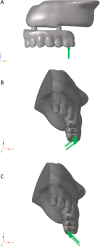

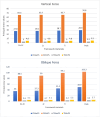
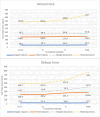
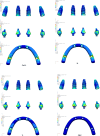
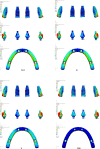
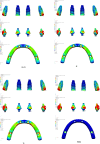
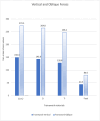
Similar articles
-
Investigation of Stress Distribution Between Two Different Implant Concepts in Implant- Supported Maxillary Prostheses with Different Framework Materials: A Finite Element Study.Int J Prosthodont. 2025 May 21;38(3):331-338. doi: 10.11607/ijp.9268. Int J Prosthodont. 2025. PMID: 39699968
-
Comparison of Different Frameworks and Implant Angulations in All-On-Four and Six Concepts: A Finite Element Analysis.Clin Implant Dent Relat Res. 2025 Aug;27(4):e70078. doi: 10.1111/cid.70078. Clin Implant Dent Relat Res. 2025. PMID: 40626455
-
Static and dynamic stress analysis of different crown materials on a titanium base abutment in an implant-supported single crown: a 3D finite element analysis.BMC Oral Health. 2024 May 10;24(1):545. doi: 10.1186/s12903-024-04328-0. BMC Oral Health. 2024. PMID: 38730391 Free PMC article.
-
[Analysis of polyetheretherketone framework on the stress distribution of implant-supported fixed maxillary prosthesis: 3-D finite element analysis].Shanghai Kou Qiang Yi Xue. 2024 Aug;33(4):367-372. Shanghai Kou Qiang Yi Xue. 2024. PMID: 39478392 Chinese.
-
Mechanical behavior of hybrid custom implant abutments with various crown materials: a 3D finite element analysis.BMC Oral Health. 2025 Jul 5;25(1):1106. doi: 10.1186/s12903-025-06445-w. BMC Oral Health. 2025. PMID: 40618097 Free PMC article.
Cited by
-
Biomechanics of different thread designs of dental implants assisting unilateral free end mandibular partial dentures.BMC Oral Health. 2025 May 28;25(1):819. doi: 10.1186/s12903-025-06255-0. BMC Oral Health. 2025. PMID: 40437488 Free PMC article.
-
Comparison of Surface Strains of Polymeric Frameworks for Fixed Implant-Supported Prostheses: A Digital Image Correlation Study.Materials (Basel). 2025 Apr 9;18(8):1700. doi: 10.3390/ma18081700. Materials (Basel). 2025. PMID: 40333280 Free PMC article.
References
-
- Agliardi E, Clerico M, Ciancio P, Massironi D. Immediate loading of full-arch fixed prostheses supported by axial and tilted implants for the treatment of edentulous atrophic mandibles. Quintessence Int. 2010;41:285–93. - PubMed
-
- Agliardi E, Panigatti S, Clerico M, Villa C, Malò P. Immediate rehabilitation of the edentulous jaws with full fixed prostheses supported by four implants: interim results of a single cohort prospective study. Clin Oral Implants Res. 2010;21:459–65. - PubMed
-
- Misch CE. Contemporary implant dentistry. 3rd ed. St Louis: Mosby; 2007.
-
- Drago C. Ratios of cantilever lengths and anterior-posterior spreads of definitive hybrid full-arch, screw-retained prostheses: results of a clinical study. J Prosthodont. 2018;27:402–8. - PubMed
-
- Patras M, Martin W. Simplified custom impression post for implant-supported restorations. J Prosthet Dent. 2016;115:556–9. - PubMed
MeSH terms
Substances
Grants and funding
LinkOut - more resources
Full Text Sources

